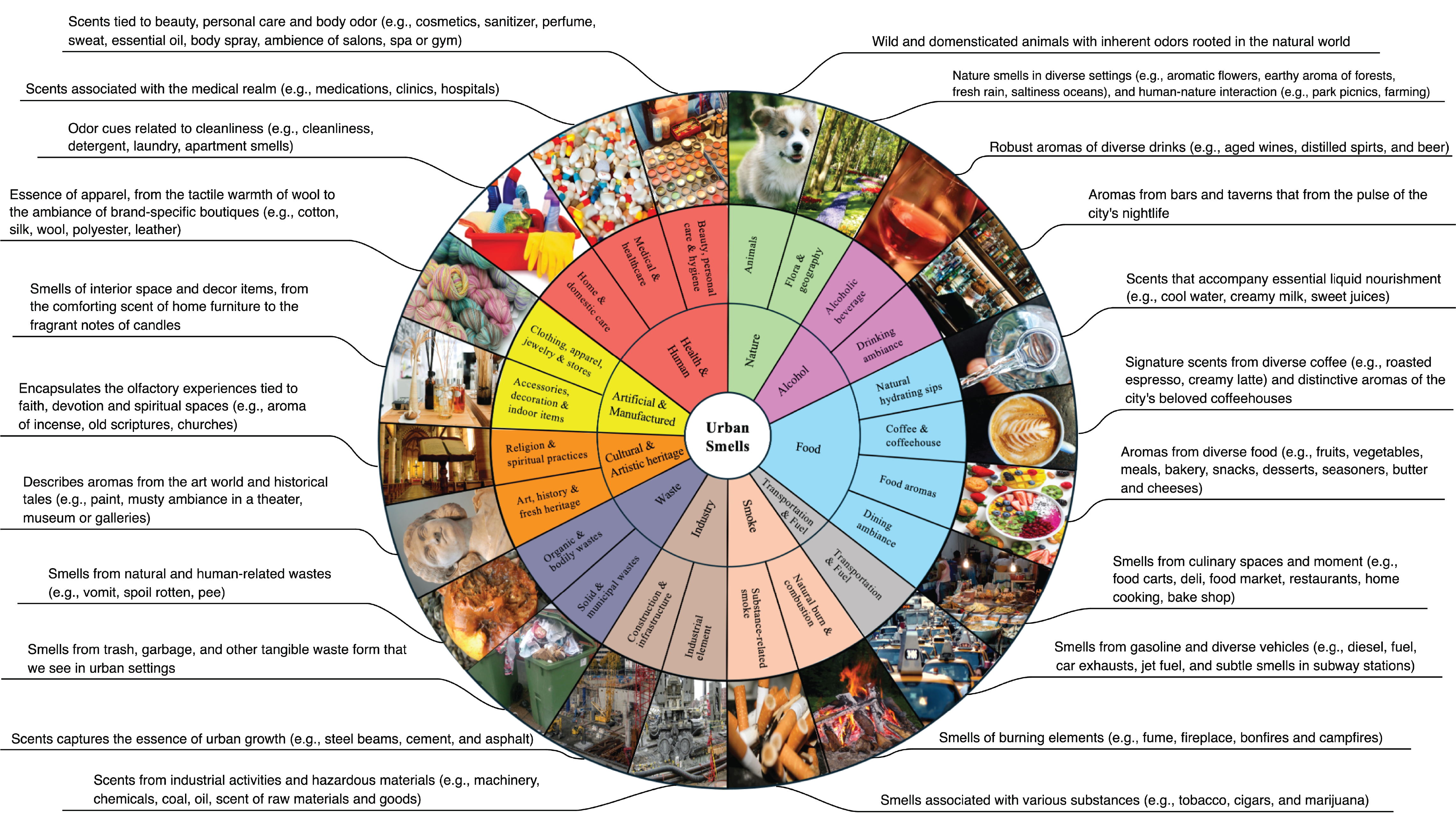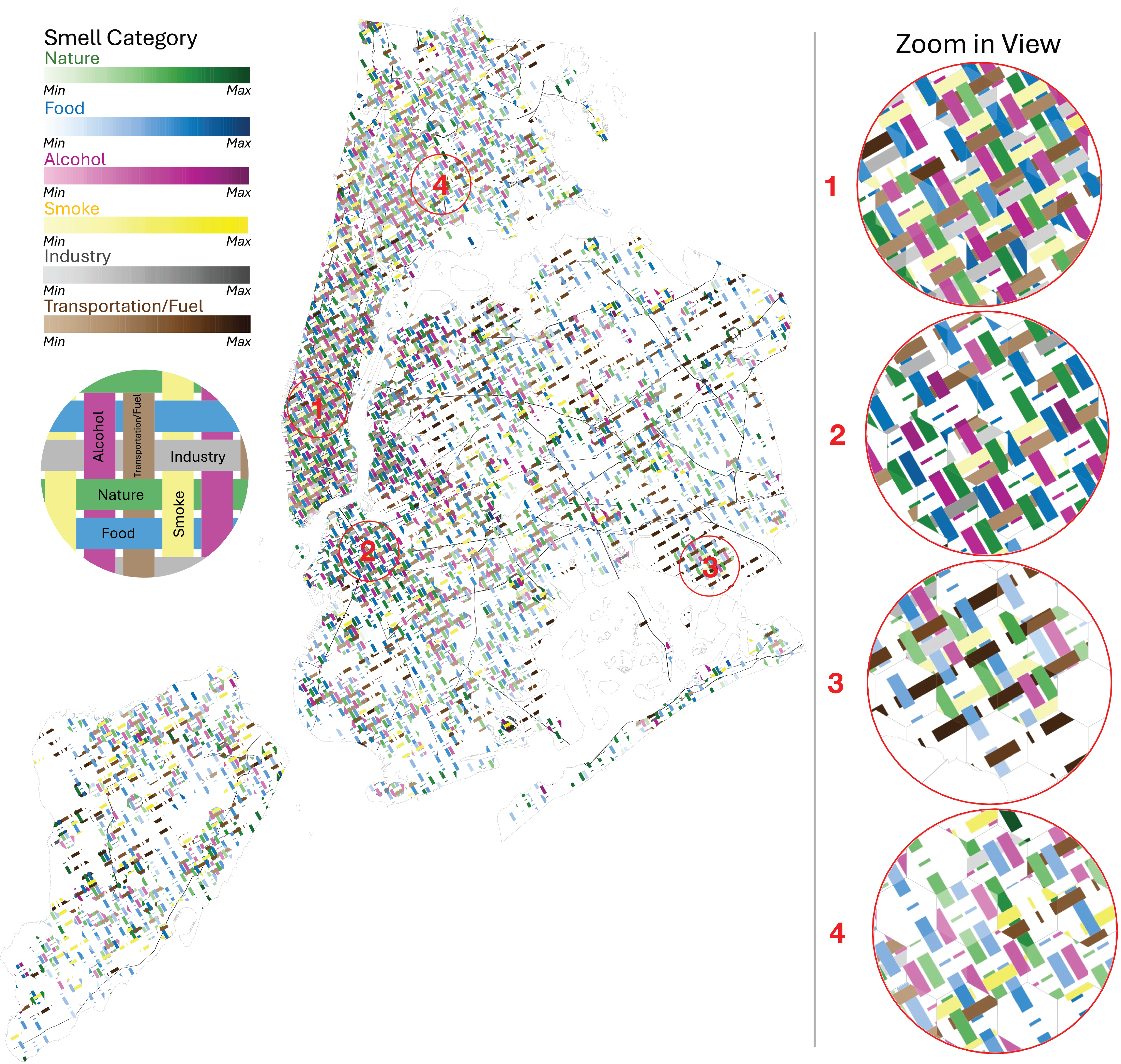Smellscape
Mapping the Invisible-Decoding Perceived Urban Smells through Geosocial Media in New York City
Smells can shape people’s perceptions of urban spaces, influencing how individuals relate themselves to the environment both physically and emotionally. Although the urban environment has long been conceived as a multisensory experience, research has mainly focused on the visual dimension, leaving smell largely understudied. This paper aims to construct a flexible and efficient bottom-up framework for capturing and classifying perceived urban smells from individuals based on geosocial media data. Thus, increasing our understanding of this relatively neglected sensory dimension in urban studies. We take New York City as a case study and decode perceived smells by teasing out specific smell-related indicator words through text mining techniques from a historical set of geosocial media data (i.e., Twitter/X). The dataset consists of over 56 million data points sent by more than 3.2 million users. The results demonstrate that this approach, which combines quantitative analysis with qualitative insights, can not only reveal “hidden” places with clear spatial smell patterns, but also capture elusive smells that may otherwise be overlooked. By making perceived smells measurable and visible, we can gain a more nuanced understanding of smellscapes and people’s sensory experiences within the urban environment. Overall, we hope our study opens up new possibilities for understanding urban spaces through an olfactory lens and, more broadly, multisensory urban experience research.

To interpret and visualize the smellscape more easily, we group smells into different categories and sub-categories (see Fig.2).

Turning to visualizing our findings, we first visualize the overall smellscape in NYC. As neighborhoods can have multiple smells associated with them, which makes visualization of the overall smellscape difficult. To address this complexity, we incorporated the weaving mapping method proposed by O’Sullivan and Bergmann (2022). More specifically, the weaving map visualizes multiple attributes simultaneously through the metaphor of woven material. It uses the concept of ‘strands’ to represent attributes. These strands interlink across boundaries, enabling multiple attributes to be reviewed simultaneously with distinct directional patterns. In Figure 4, we utilized this method to illustrate the overlaps of smell categories within each neighborhood, with each strand representing one specific smell category. Given the uneven prevalence of smell categories across the city, we have chosen to represent only the six most prevalent categories. This selective representation not only acknowledges the complex overlap of smells but also ensures clarity and effectiveness in our visual presentation.
To illustrate how the weaving map facilitates conceptual interpretation of different smells pervading the city spaces, we examine four areas (see zoom-in view in Fig.3). For instance, Area 1, near Midtown Manhattan, displays a rich “tapestry” of all six smell categories. In this area we find food (blue strands) and alcohol (purple strands) smells, likely emanating from street vendors, various restaurants and bars, reflecting a diverse and vibrant urban life. It is also characterized by major transportation hubs or intersections with heavy traffic. The proximity to the Lincoln Tunnel, which channels a constant flow of cars and buses could also contribute to the observed transportation/fuel smells (brown strands). Additionally, the present industrial (gray strands) and smoke (yellow strands) smells suggest, for example, construction activities, indicating ongoing urban development within the area. Another example–Area 3, encompasses John F. Kennedy (JFK) International Airport. Marked by significant transportation/fuel smells, it aligns with its primary urban function as a major transportation hub, yet it also intertwines with subtle hints of food and alcohol smells, indicating the airport’s eateries and bars. These examples demonstrate how different urban spaces can be distinguished by their olfactory profiles, underscoring the interaction between daily activities and urban forms and functions in shaping the city’s smellscape.

Figure 3. An overview of the six dominant overlapping smells across NYC using the weaving mapping method. The weaving map uses the concept of ‘strands’ to represent attributes. Each strand here represents one specific smell category, with the intensity of the color changing based on the density of that smell category within each neighborhood (i.e., grid cells).